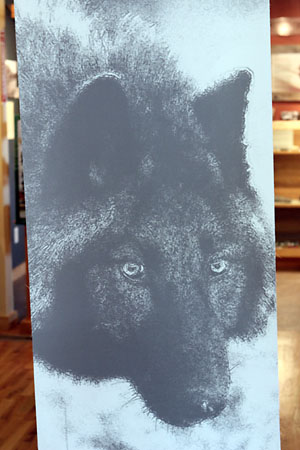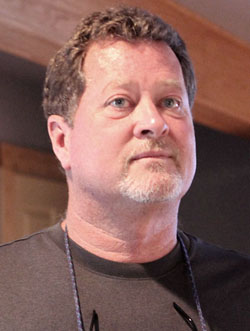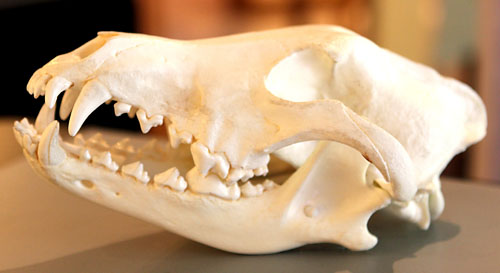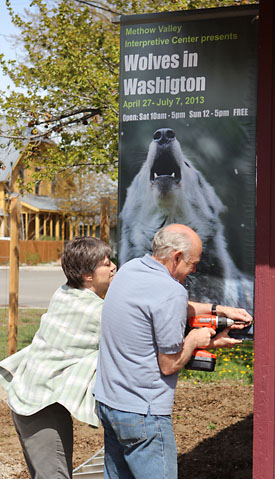home | internet service | web design | business directory | bulletin board | advertise | events calendar | contact | weather | cams

 A piece of the Burke Museum exhibit about wolves on display at the Methow Valley Interpretive Center in Twisp at TwispWorks. A piece of the Burke Museum exhibit about wolves on display at the Methow Valley Interpretive Center in Twisp at TwispWorks.Here on Their Own On April 26 it became legal to shoot wolves—without a permit—that are "caught in the act" of attacking livestock or domestic animals in Washington state. But the ruling does not apply to wolves in the Methow Valley, which unlike those elsewhere in the state, are under federal protection as an endangered species. However, if the federal government delists the gray wolf as expected later this year, any wolves “caught in the act” of attacking livestock in the Methow could then also legally be killed without a permit. The decision was made by the Washington State Fish and Wildlife Commission, which issued an "emergency" ruling allowing an attacking wolf to be killed without first notifying wildlife officials of the predator’s attack and obtaining a permit to shoot only if it returns. “We can rescind it at any time,” said fish and wildlife commissioner Jay Kehne of the new ruling. He explained the commission’s decision during a presentation on Washington’s wolves at the Methow Valley Interpretive Center Sunday (4/28) as part of the Burke Museum’s traveling exhibit on wolves. “We think it needs to be tweaked. It should be flexible,” Kehne said of the state’s wolf management plan. The ruling comes with strict caveats, according to Kehne. The shooter must notify wildlife officials of the kill within 24 hours so it can be investigated. If the kill turns out not to meet the "caught in the act" criteria, the shooter will be liable for all penalties that apply to those who shoot wolves without a permit, he said. Kehne, a trained wildlife biologist and hunter who is an outreach official in Okanogan County for Conservation Northwest, said he does not believe that many wolves will be killed under the new provision. However, he said it’s important wolves that have learned to attack livestock be killed because they will teach other wolves in the pack to emulate their behavior.  Washington State Fish and Wildlife Commissioner Jay Kehne is also an outreach official for Conservation Northwest. He expects wolves will recover in Washington State. Washington State Fish and Wildlife Commissioner Jay Kehne is also an outreach official for Conservation Northwest. He expects wolves will recover in Washington State.“You can’t take that bad wolf and move it,” he said, because it will continue to kill livestock wherever it goes. The focus must be on saving the rest of the pack by preventing the other animals from learning to kill livestock, Kehne said. This means that any wolf that becomes a livestock predator must be killed, he said. Biologists have learned that for every seven packs of wolves, one pack contains wolves that kill livestock. Despite such incidents as the poaching that seems to have reduced Twisp’s Lookout pack to two animals, Kehne said wolves will recover in Washington to the point where their presence will affect not only ranchers and farmers but everyone all over the state. For example, recreationists who take their dogs into the wilderness will need to be mindful of the fact that wolves kill domestic dogs as well as coyotes, he said. Asked how many humans have been killed in this country by wolves, Kehne answered: “In North America in all recorded history there have been two.” Washington grey wolves such as the Lookout Pack that live west of Highway 97 are federally listed as an endangered species. However the federal government is expected to delist all wolves and give management responsibility to state regulators in May, said Kehne. But he said he expects it would take until at least October before the delisting would take effect. The federal delisting will not affect this state’s wolf management program, according to Kehne, who said the grey wolf will not be taken off the endangered species list in Washington by state regulators until there are 15 breeding pairs dispersed throughout the state.  This wolf skull is also part of the Burke traveling exhibit. This wolf skull is also part of the Burke traveling exhibit.
One way to prevent wolf problems is to end the practice of dumping dead livestock and other animals into “bone yards” on farms and ranches, said Kehne. “That’s got to stop,” he said. “It brings wolves where they are not supposed to be.” He urged local ranchers and farmers to have “a [bone yard] cleanup program in your community.” Most ranchers turn their cattle loose and leave them unattended on open range. “It’s going to be tough to do that anymore with wolves on the scene,” said Kehne. But ranchers in other states who have put a range rider out with the herd report no wolf losses and have heavier animals because the herd is kept together, he said.  Methow Valley Interpretive Center director Carolyn Schmekel and husband Glenn Schmekel prepare for the Burke Museum's traveling wolf exhibit, which can be seen on Saturdays and Sundays at the Center from now until July 7. Methow Valley Interpretive Center director Carolyn Schmekel and husband Glenn Schmekel prepare for the Burke Museum's traveling wolf exhibit, which can be seen on Saturdays and Sundays at the Center from now until July 7.Kehne disputed a commonly-held notion that wolves kill for fun because they sometimes don’t immediately eat what they have killed. “They don’t kill for the fun of it,” said Kehne, who described wolves as “opportunistic.” They typically return to the kill, sometimes much later, to eat what they killed, he said. The controversy over re-establishing the grey wolf in the state has led critics to charge that they’re being brought in by humans, but Kehne said wolves are getting here on their own. Wolves are apex predators in a changing climate that’s likely affecting their food source, he explained. They disperse widely in search of food, routinely traveling hundreds of miles to establish new territories. DNA tests show the Lookout Pack is related to wolves found in British Columbia, and the Teanaway Pack sprang from the Lookout Pack, he said. Because only the alpha male and alpha female in any pack are allowed to breed, eventually the other animals that are not getting enough food or sex break off and disperse to make new packs, he said, adding: “They howl to find each other.” Packs living on the food base available in this region typically number from seven to nine animals, he added, though wolves living near a large carnivore base can reach as high as 37 wolves. People who think wolves are not native to Washington are misinformed, he indicated. Between 1857 and 1859, 14,810 wolf pelts were traded at four trading posts within the present boundaries of the state. It’s possible to determine if an animal was killed by a wolf because of how it was killed, he said. “Dogs don’t know how to kill,” he said, and “They don’t eat” the carcass. Animals killed by wolves have wounds on the hind end while “cougars go for the throat.” Wolves “go for the heart and liver because that’s where the energy is.” And, he added, a good way to tell if an animal track belongs to a wolf or a coyote is to measure: coyote tracks are never as large as three inches across but wolf tracks start at three-and-one-half inches. “We have to get to wolf normal,” said Kehne. He urged wolf proponents and opponents to “try to get to the middle, because that’s where the solution is.” 4/29/2013 Comments Carter Niemyer now has a short but illuminating interview on the internet, for those without the time to read his book: WOLFER: A Memoir. He is currently the most experienced person dealing with wolves and livestock, and consequently is attacked by both political extremes. If you haven't yet been exposed to irrational left wing opinions, looking up Carter will be informative. Eric Burr Mazama
|